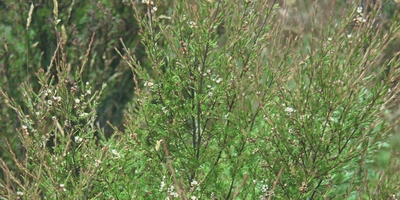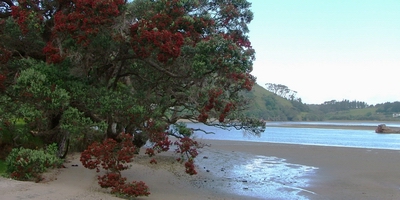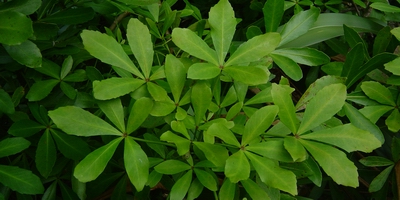Back-dune plants
The back-dune area is the most stable and sheltered of the three dune zones.
Back-dunes can range in width from a narrow area with limited plant species, to an expansive dune complex several kilometres wide. They provide a range of habitats and can support many plant and animal species.
Sand Kanuka
Rawiri | Kunzea ericoides var. linearis

Sand kanuka is endemic to the northern North Island and is most abundant from Kaitāia north. This variety of kanuka is in serious decline and is recommended for use in back-dune restoration projects. .
Description:
Sand kanuka is a small tree usually around 5m, but can grow up to 10m. The leaves and flowers are smaller than those of manuka and the leaves are softer.
Flowers and seeding:
Small white flowers appear from November to January and seeds from December to June.
Establishment:
Sand kanuka can be grown from seed.
Pohutukawa
Metrosideros excelsa

Pohutukawa are an iconic feature of Northland beaches. The flowers provide nutrition for large numbers of native creatures including geckos which help in pollination.
Description:
This large, evergreen tree often has multiple gnarled sprawling trunks.
Flowers and seeding:
Bright red flowers are present between October/November and January. Seeds appear from March to April.
Threats:
Pohutukawa are most at risk from possum browsing, which can seriously damage or kill trees. The roots are damaged by trampling and vehicles, while large trees are vulnerable to fire.
Establishment:
It can be grown from fresh seed collected from natural stands along the coast. Seedlings thrive best in sites with well-drained soil and side shelter from adjacent plants. Choose planting sites carefully to avoid blocking views as trees grow.
Houpara
Coastal five-finger | Pseudopanax lessonii

This hardy, bright-green native tree is useful for planting degraded back-dunes in combination with other species.
Description:
This small tree grows up to 6m tall. It has stout branches and glossy, green, leathery, hand-shaped leaves, often in groups of five leaflets.
Flowers and seeding:
It has green coloured flowers, and dark purple, fleshy fruit appear in autumn.
Threats:
Houpara is palatable to stock. Rabbits can ring-bark newly established plants.
Establishment:
Houpara can be grown easily from seed, and establishes well on back-dune sites.
Other back-dune plants
- Taupata Coprosma repens
- Tauhinu Ozothamnus leptophyllus
- Ngaio Myoporum laetum
- Karo Pittosporum crassifolium
- Karamu Coprosma robusta
- Karaka Corynocarpus laevigatus
- Mingimingi Leucopogon fasciculatus
- Kohekohe Dysoxylum spectabile
